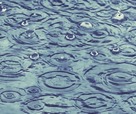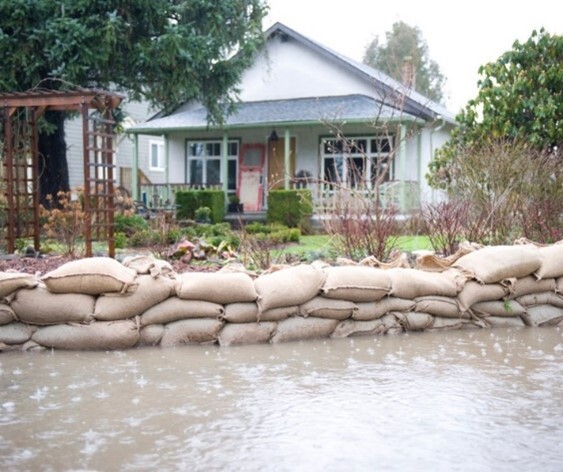WATER QUALITY IMPROVEMENTS

Preparing for and Managing Rain Events
World Water Day is on March 22nd and serves as a great reminder of how precious our rainfall and water resources are. Rainfall keeps ecosystems alive, enhances our landscapes, and replenishes our water supply. But with this year’s severe storms, we may find it difficult to appreciate all of this water. Excess runoff from rain can carry pollutants from the street into the storm drain system where they can enter our local waterways untreated. However, when rainfall is collected, harvested, and managed effectively to reduce the impacts of stormwater, rainfall can have endless benefits. Follow these guidelines below on how to make the best of rainfall by preparing for and managing rain events, so we can appreciate its benefits on World Water Day and always.
|
Make the best of rainfall. Rainfall can replenish our water supply, nourish our landscape, and be conserved and diverted for other uses. When captured effectively through proper rain catchment methods or the installation of rain gardens, polluted stormwater runoff can be prevented from leaving your property.
-
Capture or harvest rainfall to use it on other areas of your landscape. Not only will you be getting free water to use on your landscape, but you will also be conserving water, saving money, and protecting our waterways from polluted runoff. The County’s Waterscape Rebate Program, along with local partnering organizations, offers a variety of rain-saving rebates that help residents divert runoff and capture rainfall for their gardens.
-
Install rain gardens with vegetation in a low spot in your yard where water naturally collects. A rain garden will not only beautify your yard, but it also has filtering properties that help remove pollutants from stormwater runoff. Rain gardens are effective in removing up to 90% of nutrients and chemicals and up to 80% of sediment from rainwater runoff. Compared to a conventional lawn, rain gardens allow for 30% more water to soak into the ground, which reduces the amount of water running off of your property. For tips and project ideas for getting started with your rain garden, check out the BeWaterWise brochure on How to Make a Rain Garden.
Prepare and Manage for Rain Events Erosion and flooding brought about by rainfall can worsen stormwater pollution. Every time it rains, water runs off impermeable surfaces, such as roofs and driveways, collecting pollutants such as soil and sediment, garden chemicals, auto oil, and trash and yard debris. This polluted runoff enters storm drains, untreated, and flows directly into nearby streams, rivers, lakes, and other waterways, eventually reaching our ocean. The EPA estimates that pollutants carried by rainwater runoff account for 70% of all water pollution. By managing erosion, maintaining your storm drain system, and protecting against flooding, you will be helping to prevent stormwater runoff and pollution.
-
Keep your storm drains clear. Pollutants such as trash, debris, sediment, oil and grease, can accumulate at storm drain inlets and block storm drains. By keeping your storm drain free from these pollutants you can prevent stormwater pollution and reduce the risk of flooding. If you see trash or debris in the storm drain system, contact the County Department of Public Works Field Operations staff at 1-877-684-8000 or the Stormwater Hotline at 1(888) 846-0800
-
Control erosion to prevent soil and sediment from entering our storm drains. Runoff from properties can carry large amounts of soil and sediment. Although soil and sediment are natural substances, they become pollutants when an excess amount enters our storm drain system. These pollutants can negatively affect our water quality and harm aquatic life by filling in streams and blocking sunlight that organisms need to live. Use temporary erosion prevention techniques, or Best Management Practices (BMPs) such as sandbags, berms, fiber rolls, and silt fences to prevent erosion, or try more permanent solutions such as planting ground cover. Additional resources to prevent and control erosion can be found on the County’s Soil and Sediment webpage.
-
Protect your property against flooding. Flooding can not only be destructive to your property, but it can also contribute to runoff pollution when pollutants and other debris get washed into our storm drain system. Do not put debris near the curb where it can wash away and block a storm drain. Keep materials like sandbags, plywood, plastic sheeting, and lumber handy for emergency waterproofing. Learn more through the County’s brochure on how to Protect Your Property Against Flooding. If you would like to report flooding or damage to a public road, please download the SD County Tell Us Now App from the County App Center.
If you were affected by the recent storms, please visit the County’s website https://www.alertsandiego.org/en-us/recovery.html for helpful resources and assistance. To learn more about the County’s ongoing efforts to protect our water resources and watersheds year-round, and preserve the quality of our waterways, please visit the Watershed Protection Program webpage.

|